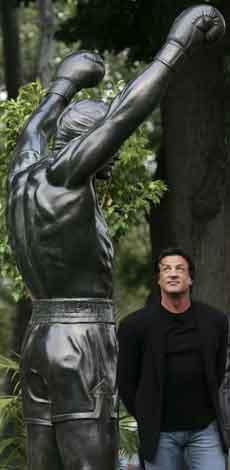Rocky Balboa, or more specifically a statue of the Hollywood palooka, boxing gloves raised in triumph is being restored to a spot outside the Philadelphia Museum of Art, the winner by a split decision between fine art and pop culture. Despite complaints that the statue is a piece of kitsch undeserving of display near Renoirs and Monets, the city art commission voted 6-2 Wednesday to move the 2,000-pound bronze out of storage and put it on a street-level pedestal near the museum steps.
The steps were the setting for one of the most famous scenes in Sylvester Stallone’s 1976 movie “Rocky” and have been a tourist attraction ever since, with visitors imitating the Italian Stallion’s sweat-suited dash to the top. (Of course, after bounding up the 72 steps and pumping their fists in the air like Rocky, the tourists often turn around and leave without setting foot in the museum.)
The 8-foot-6 Rocky is expected to be on his granite pedestal in time for a dedication ceremony Friday.
“We’re thrilled,” City Commerce Director Stephanie Naidoff said. “What more wonderful a symbol of hard work and dedication is there than Rocky?”
The two commission members who voted against the move, Moe Brooker, artist and professor at Moore College of Art and Design, and University of the Arts President Miguel Angel Corzo said the site was inappropriate.
“It’s not a work of art, and (…) it doesn’t belong there,”Moore said.
Corzo suggested he might resign from the commission over the vote and said placing the pugilist near the museum goes against the commission’s desire to “raise the standards of the city.”
He said the issue for him was not whether the statue was art, pointing out the debatable aesthetic value of some of the Philadelphia museum’s works like the porcelain urinal by Avant-Garde artist Marcel Duchamp. But, instead, he questioned whether Rocky deserved to be neighbors with sculptures such as Rodin’s “The Thinker,” which sits nearby on the Benjamin Franklin Parkway.
But the majority of commissioners who approved the move said Rocky has become synonymous with Philadelphia.
“This is not art as it has been defined by aesthetic standards, commissioner Emanuel Kelly said, who scored the fight for Rocky.
The sculpture by A. Thomas Schomberg was commissioned by Stallone for a scene in “Rocky III” (1982) and also appeared in “Rocky V” (1990). Stallone later donated the statue to the city, and the real fight began.
The statue was installed at the top of the museum steps but was removed after just a few months when museum officials and art aficionados argued that it was merely a movie prop, and its “exaggerated proportions and caricature” would sully the internationally renowned museum’s image.









